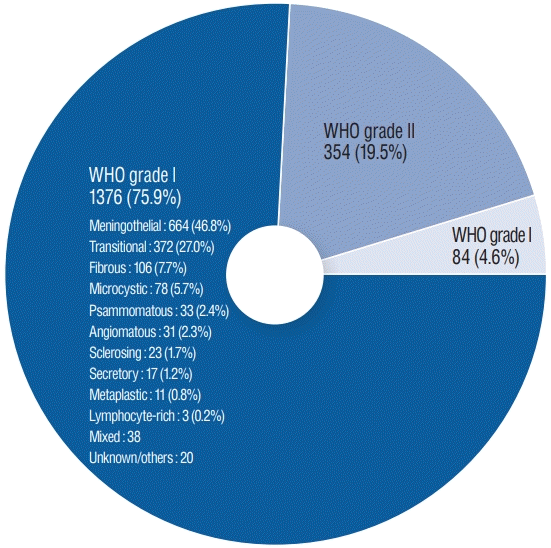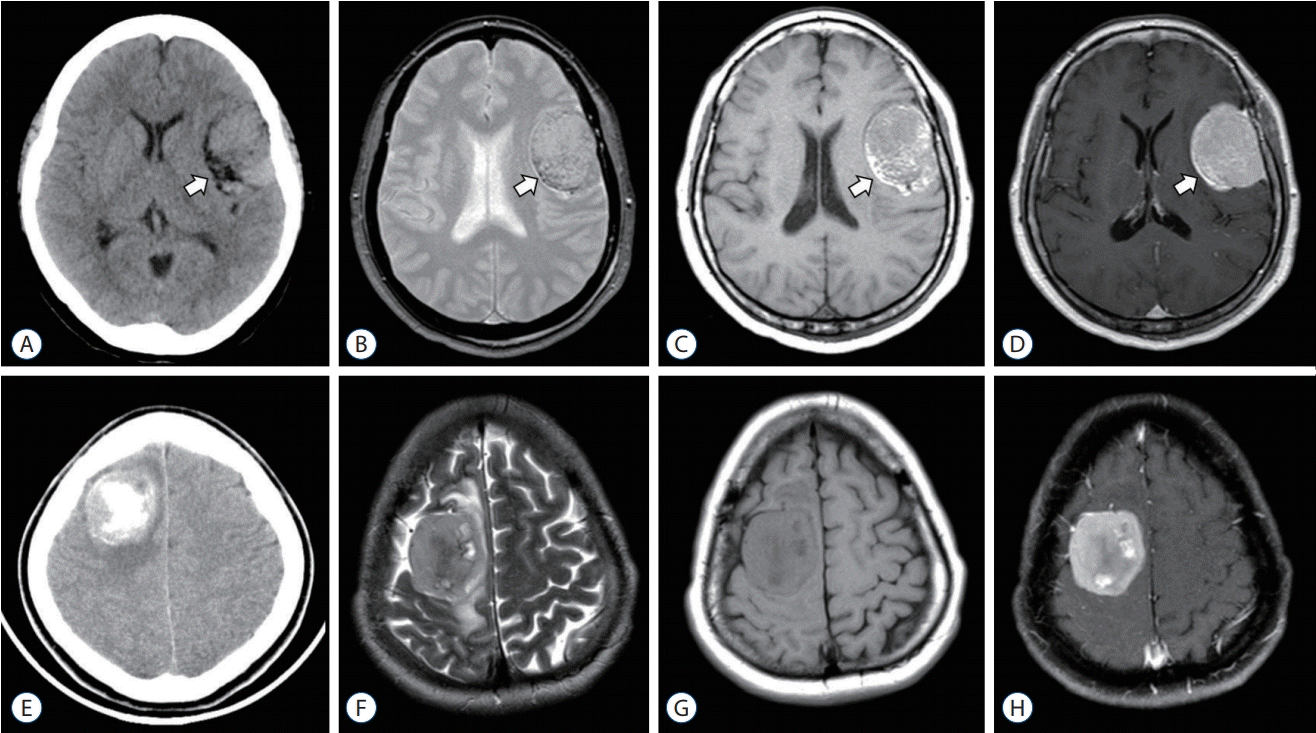1. Barresi V, Caffo M, Ieni A, Alafaci C, Tuccari G. Osteoblastic meningiomas: clinico-pathological and immunohistochemical features of an uncommon variant. J Neurooncol. 105:225–232. 2011.

2. Choi YH, Choi CY, Lee CH, Koo HW, Chang SH. Metaplastic meningioma overspreading the cerebral convexity. Brain Tumor Res Treat. 6:97–100. 2018.

3. Colnat-Coulbois S, Kremer S, Weinbreck N, Pinelli C, Auque J. Lipomatous meningioma: report of 2 cases and review of the literature. Surg Neurol. 69:398–402. discussion 402. 2008.

4. Danisman MC, Kelesoglu KS, Sivri M, Koplay M, Paksoy Y. Microcystic meningioma: difficulties in diagnosis and magnetic resonance imaging findings. Acta Neurol Belg. 117:745–747. 2017.

5. Ersoz S, Yilmaz ZS, Eyuboglu I, Yazar U. Xanthomatous meningioma: a case report. Turk Neurosurg. 29:141–144. 2019.

6. Gasparinho MG, Ferreira M, Lavrador JP, Livraghi S. Revisiting lipomatous meningioma: a case report and review of an unusual entity. Int J Surg Pathol. 23:399–403. 2015.
7. Ikota H, Nakazato Y. A case of metaplastic meningioma with extensive xanthomatous change. Neuropathology. 28:422–426. 2008.

8. Indiran V. Intracranial ossified metaplastic meningioma: unusual cause of headache. J Neurosci Rural Pract. 8:653. 2017.

9. Ishida M, Fukami T, Nitta N, Iwai M, Yoshida K, Kagotani A, et al. Xanthomatous meningioma: a case report with review of the literature. Int J Clin Exp Pathol. 6:2242–2246. 2013.
10. Kang H, Kim JW, Se YB, Dho YS, Choi SH, Park SH. Sclerosing meningioma : radiological and clinical characteristics of 21 cases. J Korean Neurosurg Soc. 59:584–589. 2016.

11. Kim NR, Yee GT, Cho HY. Crush cytology of secretory meningioma: a case report. Brain Tumor Res Treat. 3:147–150. 2015.

12. Krisht KM, Altay T, Couldwell WT. Myxoid meningioma: a rare metaplastic meningioma variant in a patient presenting with intratumoral hemorrhage. J Neurosurg. 116:861–865. 2012.

13. Kunimatsu A, Kunimatsu N, Kamiya K, Katsura M, Mori H, Ohtomo K. Variants of meningiomas: a review of imaging findings and clinical features. Jpn J Radiol. 34:459–469. 2016.

14. Mannoji C, Koda M, Murakami M, Kubosawa H, Yamazaki M, Okawa A, et al. Osseous metaplastic meningioma in the thoracic spine mimicking osteosarcoma: a case report. Spine (Phila Pa 1976). 38:E632–E634. 2013.
15. Murakami T, Tanishima S, Takeda C, Kato S, Nagashima H. Ossified metaplastic spinal meningioma without psammomatous calcification: a case report. Yonago Acta Med. 62:232–235. 2019.

16. Paek SH, Kim SH, Chang KH, Park CK, Kim JE, Kim DG, et al. Microcystic meningiomas: radiological characteristics of 16 cases. Acta Neurochir (Wien). 147:965–972. discussion 972. 2005.
17. Salunke P, Aggarwal A, Futane S, Nada R, Gochhait D. Osteoblastic meningioma with turtle shell: different entity from calcified meningioma. Asian J Neurosurg. 11:450. 2016.

18. Somerset HL, Kleinschmidt-DeMasters BK, Rubinstein D, Breeze RE. Osteochondroma of the convexity: pathologic-neuroimaging correlates of a lesion that mimics high-grade meningioma. J Neurooncol. 98:421–426. 2010.

19. Tang H, Sun H, Chen H, Gong Y, Mao Y, Xie Q, et al. Clinicopathological analysis of metaplastic meningioma: report of 15 cases in Huashan Hospital. Chin J Cancer Res. 25:112–118. 2013.
20. Wang DJ, Xie Q, Gong Y, Mao Y, Wang Y, Cheng HX, et al. Histopathological classification and location of consecutively operated meningiomas at a single institution in China from 2001 to 2010. Chin Med J (Engl). 126:488–493. 2013.
21. Yüksel MO, Gürbüz MS, Tanriverdi O, Özmen SA. Lipomatous meningioma: a rare subtype of benign metaplastic meningiomas. J Neurosci Rural Pract. 8:140–142. 2017.

22. Zouaoui S, Darlix A, Rigau V, Mathieu-Daudé H, Bauchet F, Bessaoud F, et al. Descriptive epidemiology of 13,038 newly diagnosed and histologically confirmed meningiomas in France: 2006-2010. Neurochirurgie. 64:15–21. 2018.







 PDF
PDF Citation
Citation Print
Print




 XML Download
XML Download